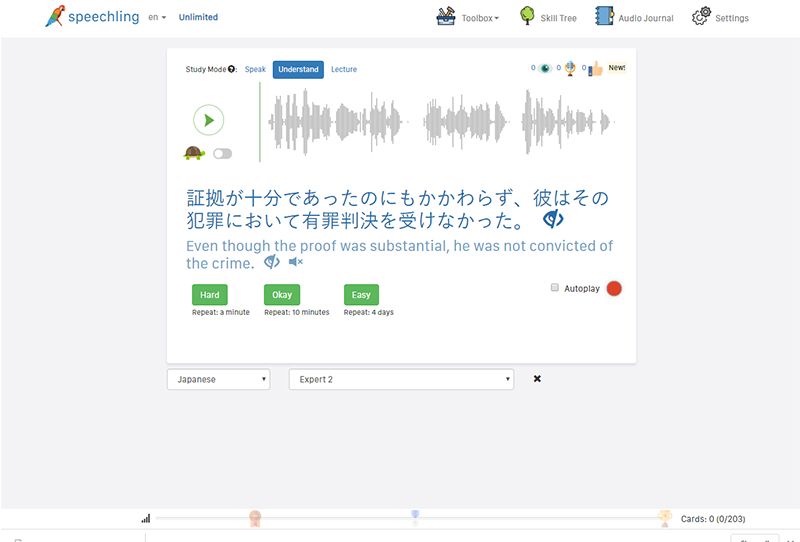How to Learn a Language Staying at Home During the COVID-19 Global Pandemic

The global pandemic sweeping through communities across the world has propelled a mixture of panic, fear, confusion, and anxiety. With most nations on either lockdown or under strict social distancing measures, most of us are experiencing heightened stress and a colorful range of emotions due to living in an unfamiliar situation.
Staying at home in isolation may induce anxiety, restlessness, and boredom in some, especially with those who thrive on social connections. However, learning a foreign language can boost your mental health. Read on for detailed advice on how to learn a language while you stay at home during COVID-19.

The Challenges Posed by the Global Pandemic
COVID-19 first began in China in December 2019 before spreading to the rest of the world. Right now, as of April 23, 2020, there are 883,826 cases (and counting) of COVID-19 in America and more than 2.7 million globally, and the cases will likely continue to rise for the unforeseeable future.
Here’s a scientific look at how the coronavirus develops:

Basically, the coronavirus is one large virus group. Its name "coronavirus" refers to the appearance of the virus particle under electronic microscopy, with tiny spiny projections (green and purple in the above image) that are proteins extending out of the central rounded shape (red color), so that it resembles a sun with rays (a “corona”). Some are not dangerous. However, COVID-19 is contagious and deadly.
The SARS-CoV2 has “long single-strand RNA viruses as its genetic material,” and "the long single RNA strand can mutate easily." The outbreak of COVID-19 mirrors previous virus disasters like SARS (Severe Acute Respiratory Syndrome) in 2002, MERS (Middle East Respiratory Syndrome) in 2014, and Ebola from 2013-2016. Although, none of these were considered a global pandemic.
When the virus makes its way into the cell of the host, it’s game over because uninfected cells tie-up with infected cells, allowing the virus to spread through the body secretly. On rare occasions, the coronavirus can move and mutate from an animal to a human, otherwise known as a “spillover event.” This is likely how COVID-19 first infected people.
Some people may experience super mild cold symptoms, while others may develop a high fever and trouble breathing (respiratory problems). However, there is neither a vaccine nor cure medicines for COVID-19. The recovery rates of those infected depend on their own immune system, although some alternative methods like TCM and acupuncture can help.
Unfortunately, COVID-19 can linger in the air for up to three hours, which is why it’s essential to wear a mask when you shop, to cover your mouth when you sneeze, and to stay six feet apart from others.
To make matters worse, the virus can live on surfaces for around 72 hours, so it’s essential to wear gloves when shopping, to sanitize and clean the products you purchase, and to wash your hands for at least 22 seconds at a time.
In medicine, the incubation period refers to the time from the moment of exposure to the invasion of an infectious agent, making you an infected host. Eventually, signs and symptoms of the disease will appear in the host.
For example, the incubation period of chickenpox is 14-16 days. The incubation period for COVID-19 can be as short as 3 days, but it can also last for way longer. In some cases, the exposed person didn't develop symptoms until 27 days had passed.
As you can see, the deadly virus spreads easily and shows limited signs of slowing down, but one way we can help flatten the growth and death curves is by social distancing, staying at home, and isolating. This approach is called "city lockdown," "state lockdown," and even "country lockdown."
As an extrovert, I definitely understand the restlessness, anxiety, and boredom some of you may be feeling due to strict lockdown or social distancing measures, but there are creative, crafty ways to help boost your mental health and overall morale. Can you guess one simple but effective activity that can help? Learning a language at home! (This is a language-learning blog, after all.)

How Learning a New Language While You Stay at Home Can Benefit Your Mental Health
In general, learning a new language can benefit the brain in numerous ways! Some research has discovered that speaking something other than your mother tongue can delay dementia by five years and can help you recover fast from a stroke.
Not only that, but bilingualism—people who can speak two languages—can stave off cognitive decline. One source notes that “Older bilingual people enjoy improved memory and executive control relative to older monolingual people, which can lead to real-world health benefits.” So why not start now?
Enough of the broad benefits. COVID-19 is wreaking havoc on our physical health, economy, and mental health. While we may not be able to control the fate of the economy, we can try to raise our spirits by learning a new language!
Note:
I definitely understand that this may not be the ideal way to boost your wellbeing. It’s totally cool to sit back, read books, chill, watch Netflix, and enjoy several glasses of wine—I’m doing this a lot, too.
Those who want to learn a language while staying at home will be happy to know that doing so can help you to connect with someone online, which can ease the pain of isolation. (I’ll unveil ways to collaborate with others shortly!) I find that after either online or a six-feet-apart social interaction, my mood meter skyrockets and my restlessness plummets.
Another way adding another language to your list can benefit you? It builds confidence! The current circumstances may be hurting your self-esteem, but building confidence can help you to make better decisions, eat better, and heighten your wellbeing.
One article describing the benefits of language learning wrote: “When we set out to achieve something and find success, it boosts our confidence levels — no matter how small the success.” Even chatting with someone online in a different language or saying a new word unexpectedly can do wonders for your confidence.
The feeling of productivity and striving towards a goal can also boost your mood and help to keep your mind in tip-top shape, too.

How to Learn a Language at Home During the Global Pandemic
1. Get cooking
That’s right! Look up some recipes online in whichever language you want to learn, and get cooking.
The list of ingredients will help to expand your vocabulary on not only food but on strange terms and words you’ve never heard of before! For example, you may want to make a classic Parisian dish like Crêpes de blé (a delicious crepe that tastes crazy good with ham and cheese), and you’ll learn that buckwheat flour is farine blé noir in French!
The combination of doing something while you learn new words can better help you memorize, too. In the end, the art of cooking may propel your sense of productivity too, which could result in a better mood and a higher sense of self-worth!
2. Turn to the media
The global pandemic has forced most of us to chill at home, propelling a heightened use of the media, whether that be listening to music and podcasts or watching movies and TV shows.
So why not learn or study a language while watching your favorite or try dancing to a song with foreign lyrics?
Listening to music in the language you want enables you to grasp more informal expressions that you may not learn in class or a formal setting. It helps to look up the lyrics and translate them. Singing songs is one of the best-used education tools for children, so why can’t adults use this technique too?
Plus, singing forces you to exercise your memory muscle, so you’ll remember new phrases in no time. Podcasts can also enhance your listening skills and get you acquainted with accents—more advanced language learners can use this tool.
Watching movies and TV shows can help a lot as well. If you’re well-versed in the language, some studies have found that it’s effective to watch the show and use subtitles in the foreign language, but if you’re just learning, start with subtitles in the foreign language but watch in your native tongue.
If you’re on Netflix, you can get social by having a Netflix party! This amazing feature allows you to watch the same movie at the same time with others and to converse via a group chat. You can ask other friends who want to learn the same language as you to join in on the fun. It’s a chance to get social while you stay at home, right?
3. Test yourself
Get out those flashcards and set aside time to quiz yourself! Some of you may find this boring but imagine sitting outside in your backyard or on your balcony while the sun shimmers (you can even tan at the same time), you have a cold beverage in one hand, and your flashcards in another. Slightly nerdy? Who cares! Self-testing is a great memory-boosting technique.
One of the best ways to test yourself with flashcards is to start over whenever you get a word wrong. Once you get through your stack, quiz yourself on a piece of paper. Write down the words in your native tongue first, and then add the words in the foreign language beside each word—without looking at your flashcards!
4. Join a language-learning platform

You may feel like you’re making progress, but you may never know until you talk to an expert! Speechling can not only improve your conversation skills, but our platform will give you the chance to interact online. It’s one way to get social, at least.
How does our platform work? Well, first things first, it’s vital to note that we offer expert advice in ten languages: French, English, German, Russian, Japanese, Spanish, Italian, Mandarin, Portuguese, Korean.
On the first day, you’ll repeat a sentence from a professional actor and record yourself. Within 24 hours, you’ll get personal feedback from one of our tutors! It’s super simple and provides a small interaction with someone else online. But wait for it...
If you learn multiple languages, you will get to experience even more connections. You can join the online community for increased interactions among other language learners. It's one way to boost your social life, right?
The best part? You get 35 coaching sessions per month for free! You can also get Speechling Unlimited for just $19.99 a month.
But that's not all! Speechling has a lot of language-learning activities other than focusing on how to speak better by recording yourself and getting personal feedback. Our comprehensive user guide details how to use Speechling.
The dictation, listening practice, flashcards, fill in the blank, searching, and multiple choice quiz tools can make learning a new language all the more entertaining. (Who needs real-life friends to entertain when you have these sweet language-learning features?)
To top it off, the application of advanced computer science algorithms for spaced repetition will help you memorize whichever foreign language you want.
5. Find a foreign language exchange partner
Get the best of both worlds and practice your pronunciation and conversation skills, and get some valuable social time during isolation with a foreign language exchange partner!
Where can you find a 21st-century-version of a pen pal from another country? You have a few options. Start by checking out Speaky, which will help you find your ideal language partner. Not your thing? Feel free to post an add on Reddit, MeetUp, or Upwork. Use social media to your advantage and join Facebook groups or search Instagram for someone looking for the same thing as you.

To Sum It Up…
Taking the time to learn a language and to interact with an expert or a language exchange partner online may help to ease the pain of isolation and restlessness just a little bit by boosting your confidence, providing you with the rewarding feeling of productivity, and elevating your self-worth.
